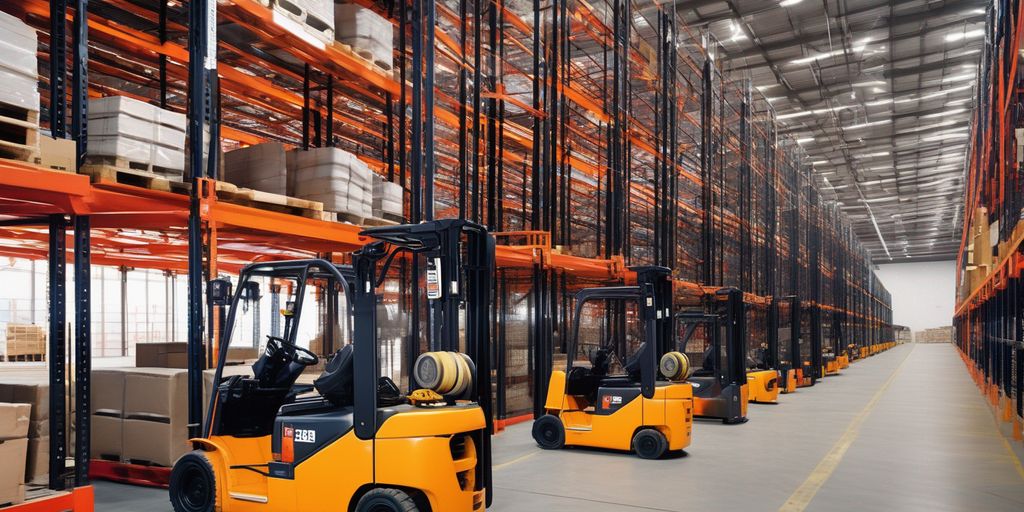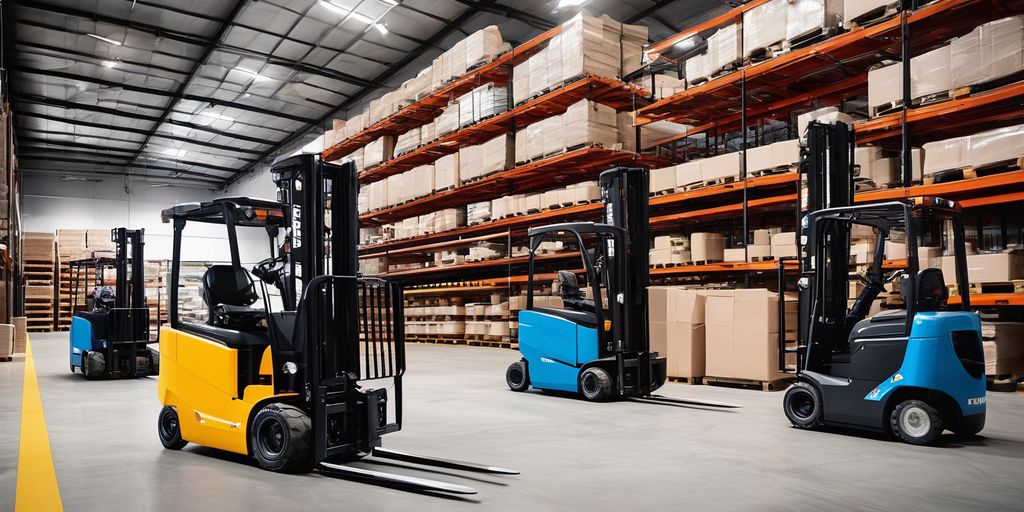Ergonomics and Forklift Operator Comfort: Why It Matters — overview
Ergonomics and comfort play pivotal roles in the efficiency and safety of forklift operations. Ensuring that forklift operators are comfortable not only enhances their ability to perform but also significantly reduces the risk of accidents and injuries. This article delves into the critical aspects of ergonomic design in forklifts, the importance of operator comfort, and how these factors contribute to overall productivity and safety in the workplace.
Key Takeaways
- Ergonomic designs in forklift seats and controls reduce physical strain and enhance situational awareness, leading to safer operations.
- Upgrading forklift seats and integrating advanced controls can boost productivity by minimizing downtime and improving operator efficiency.
- Features like suspension systems, temperature control, and ergonomic design in seats are essential for maintaining operator comfort and performance.
- Addressing specific working conditions such as extreme temperatures and noise levels is crucial to ensure operator well-being and effectiveness.
- Technological enhancements like remote operation capabilities, cameras, and sensors not only improve safety but also augment the operator's control and precision.
The Impact of Ergonomics on Forklift Operator Safety

Reducing Physical Strain
Ergonomics plays a crucial role in minimizing the physical demands on forklift operators. By designing controls and seating to support the operator's body, the risk of repetitive strain injuries and musculoskeletal disorders is significantly reduced. Proper ergonomic design can lead to extended career longevity and reduced absenteeism due to injury.
Enhancing Situational Awareness
An ergonomically designed forklift cabin enhances the operator's ability to monitor their surroundings effectively. This improvement in situational awareness is vital for preventing accidents, especially in busy or complex warehouse environments. Enhanced visibility and comfort can help operators maintain focus and react more swiftly to potential hazards.
Preventing Workplace Accidents
Ergonomic improvements not only enhance comfort but also significantly impact safety. Features like adjustable controls and better seat design contribute to a safer work environment by reducing the likelihood of accidents caused by operator fatigue or discomfort. A focus on ergonomics ensures that operators are more alert and less prone to errors that could lead to accidents.
Forklift safety is enhanced by ergonomic designs that reduce physical strain and improve operator alertness.
Boosting Productivity Through Operator Comfort

Upgrading Seats and Controls
Upgrading the operator seat or control design can have a significant impact on safety, downtime, and productivity. Simple ergonomic enhancements not only improve comfort but also reduce the risk of fatigue or injury, thereby enhancing overall efficiency.
Impact on Safety and Downtime
Comfortable operators are able to minimize strains and hazards more effectively. This sustains peak precision and skill, ultimately leading to gains across various performance KPIs. Partnering with specialists for appropriate seating and fleet retrofits can unlock more capacity without large capital investments.
Direct Benefits to Productivity
In settings where narrow profit margins are common, optimizing operator conditions provides easily accessible gains. Ergonomic improvements directly impact efficiency and safety metrics that business leaders closely monitor.
Essential Features in Forklift Seats

Ergonomic Design Considerations
Choosing the right forklift seat is critical to ensuring operator comfort, safety, and productivity. Ergonomic design is paramount, focusing on the shape and features that support the operator's body throughout the workday. Adjustable features such as lumbar support, seat height, and tilt options are essential for tailoring the seat to individual needs.
Suspension and Vibration Absorption
A key aspect of forklift seat design is the ability to absorb shocks and vibrations that come from operating the vehicle. This not only enhances comfort but also reduces the risk of long-term injury. Seats equipped with advanced suspension systems can significantly mitigate the impact of rough terrain, making operations smoother and safer.
Temperature Control Options
Operating a forklift in varying climates demands adaptable comfort features. Seats with built-in heating and cooling options provide year-round comfort, crucial in environments like cold storage facilities or outdoor operations in varying weather. This adaptability ensures that operators maintain alertness and efficiency, regardless of external conditions.
Addressing Specific Working Conditions

Cold Chain and Extreme Temperatures
In environments like cold storage areas, adjusting work schedules to minimize exposure to extreme temperatures is crucial. Operators should wear appropriate clothing and stay hydrated to maintain focus and efficiency. Heated seats can provide additional comfort and prevent the loss of concentration due to cold.
Noise and Air Quality Issues
Excessive noise and poor air quality can significantly impact operator comfort and productivity. Implementing solutions such as soundproofing and air filtration systems can create a more conducive working environment. Regular maintenance and checks ensure these systems remain effective.
Lighting and Visibility Challenges
Proper lighting is essential, especially in areas with low visibility. Efforts should be made to perform tasks during daylight hours or provide adequate artificial lighting. This not only enhances safety but also helps in maintaining high levels of productivity and reducing the risk of accidents.
The Role of Technology in Enhancing Operator Comfort

Remote Operation Capabilities
With the advent of remote operation technologies, forklift operators can now control vehicles from a comfortable workstation, significantly reducing physical strain and enhancing safety. This shift not only improves comfort but also allows for longer periods of operation without fatigue.
Integration of Cameras and Sensors
Modern forklifts are engineered with cameras and sensors that enhance the operator's situational awareness and safety. These technologies help in navigating tight spaces and avoiding obstacles, which is crucial in busy warehouses and industrial environments.
Safety Systems and Operator 'Superpowers'
Advanced safety systems and technologies augment the operator's capabilities, effectively giving them "superpowers". These include dynamic mast control systems that minimize oscillation during lifting and lowering, enhancing both comfort and precision in operations.
Why Seat Quality is Crucial in Forklift Operations

Influence on Operator Performance
The quality of a forklift seat directly influences operator performance. Comfortable and ergonomic seating reduces the risk of physical strain and fatigue, conditions that can lead to mistakes and accidents in the workplace. A seat that supports the operator’s body correctly can improve concentration and efficiency, directly impacting productivity and operational success.
Reducing Risk of Injuries
Bad seats can lead to injury, poor concentration, and bad posture. It is crucial to take into account ergonomics when choosing a seat for your workers. This ensures they are safe and productive. Regular forklift maintenance is crucial to prevent accidents. Ignoring warning signs can lead to malfunctions. Proper inspection and brake maintenance enhance safety and prevent costly repairs.
Improving Concentration and Efficiency
Selecting a new forklift seat might seem straightforward, but the right choice can significantly impact your operations. A forklift is only as effective as its operator, and the seat plays a pivotal role in ensuring their comfort, safety, and productivity. Let’s dive into what makes a forklift seat not just good, but great, and what features you should consider before making a purchase.
Considerations for Different Forklift Models

Stand-up vs. Sit-down Forklifts
Choosing between stand-up and sit-down forklifts hinges on several operational factors. Stand-up models are ideal for tasks requiring frequent mounting and dismounting, while sit-down forklifts offer better comfort for longer travel times. It's crucial to assess how often operators leave the truck and the typical duration of their travel to make an informed decision.
Operator Movement and Ergonomics
Ergonomics play a significant role in selecting the right forklift. A model that aligns with the operator's natural movements and minimizes strain can greatly enhance comfort and reduce fatigue. Consider the operator's need to move around and the ease of operating the controls when choosing a forklift model.
Choosing the Right Equipment for the Task
Selecting the appropriate forklift model also depends on the specific tasks and environment. Factors such as the layout of the workspace, the type of loads handled, and the frequency of use should guide your decision. It's advisable to consult with a dealership to test different models to ensure they meet your operational needs.
Conclusion
In conclusion, enhancing the ergonomics and comfort of forklift operators is not just a matter of health and safety, but also a strategic approach to boosting productivity and efficiency in warehouse operations. Comfortable seating, optimal control design, and additional features like suspension systems and temperature control significantly reduce physical strain and improve operator focus. By investing in ergonomic improvements, businesses can ensure their operators are not only safer but also more effective, leading to a more successful and sustainable operation overall.
Frequently Asked Questions
Why is ergonomic design important for forklift seats?
Ergonomic design in forklift seats is crucial as it reduces physical strain, fatigue, and the risk of injuries, which can lead to mistakes and accidents. Proper support enhances the operator’s concentration and efficiency, impacting productivity positively.
How does operator comfort influence forklift productivity?
Comfortable operators experience less fatigue and physical strain, leading to better situational awareness and productivity. Upgrading seats and controls can significantly reduce downtime and safety incidents, thereby boosting overall operational output.
What are essential features to look for in a forklift seat?
Key features include ergonomic support, suspension systems for shock and vibration absorption, and temperature control options like heating and ventilation to accommodate different working environments.
How does seat quality affect operator safety?
High-quality seats that provide proper ergonomic support reduce the risk of physical discomfort and injuries. This ensures that operators maintain high levels of alertness and efficiency, which are critical for safe forklift operation.
What role does technology play in enhancing forklift operator comfort?
Technology such as remote operation capabilities, integration of cameras and sensors, and advanced safety systems enhance the operator's capabilities and comfort, reducing physical demands and increasing safety.
Why might a stand-up forklift be preferable in certain conditions?
Stand-up forklifts are ideal when operators need to frequently get on and off the truck, as they allow for easy access without the need to buckle and unbuckle a seatbelt, reducing strain and increasing efficiency in certain operational scenarios.




Leave a comment
This site is protected by hCaptcha and the hCaptcha Privacy Policy and Terms of Service apply.